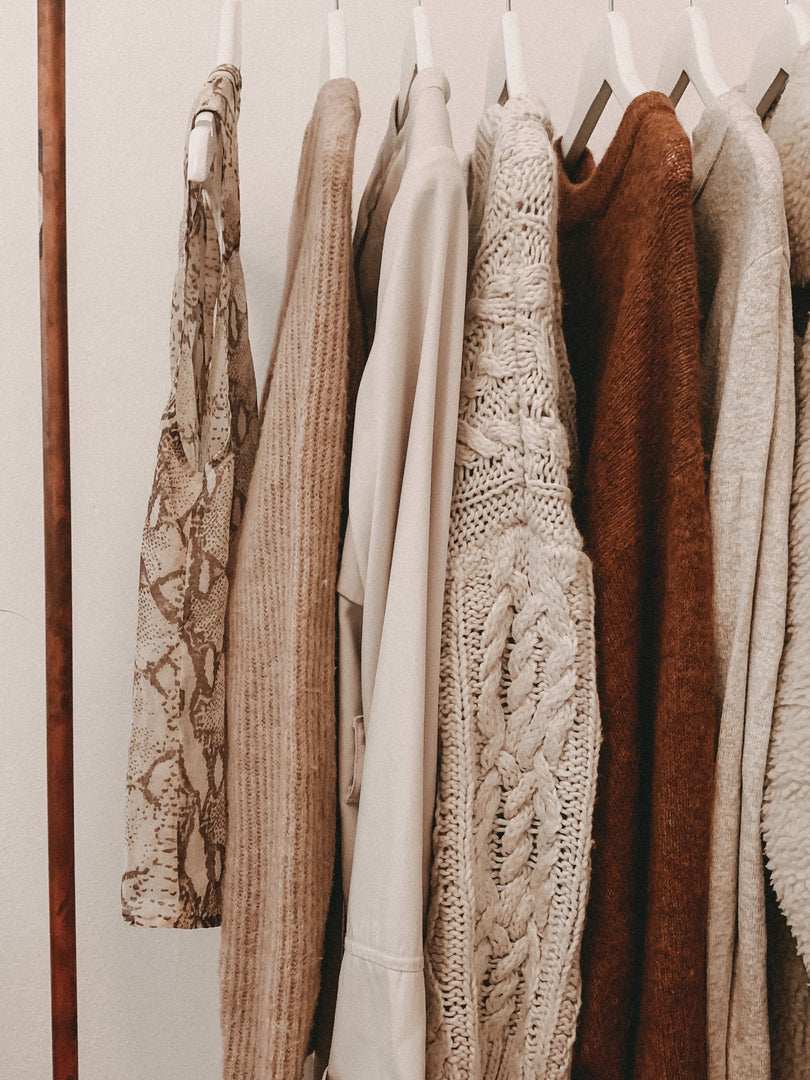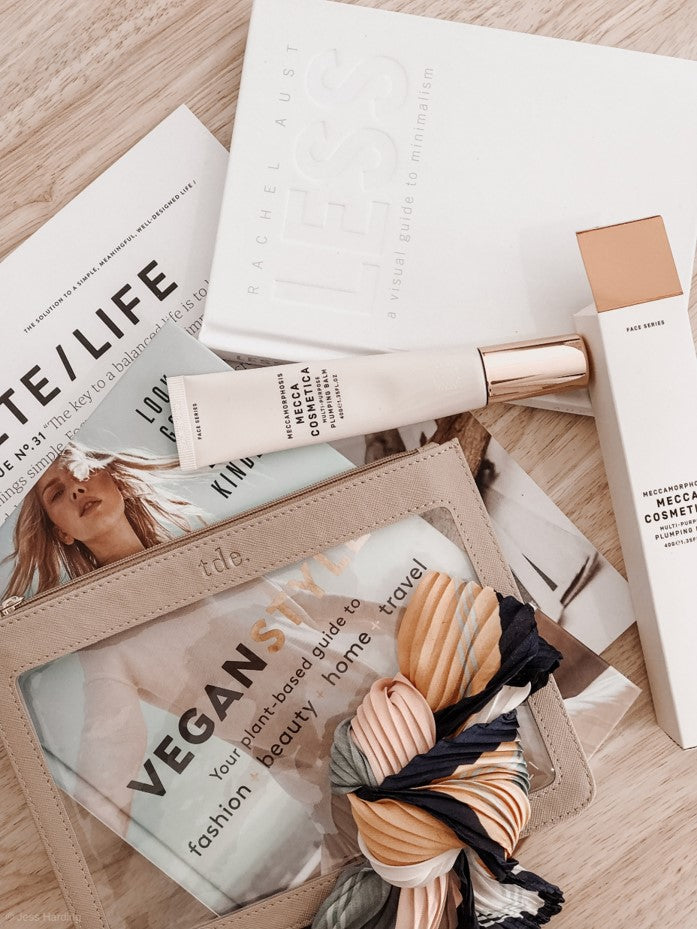So you’re new to the idea of sustainable fashion, and you’re overwhelmed with the information overload that is being thrown your way and the amount of time and energy that transitioning to a clean closet seems to require. If this hits close to home—and trust me, we get it and we’re right there with you—then this article on detoxing your closet is made for you. Crafted with hectic lifestyles in mind, this guide will give you the skinny on some of the biggest sustainability issues currently facing the fashion industry as well as quick, simple actions that you can take today to yield the greatest sustainable impact in your closet (and your life!).
Before we start detoxing, it’s important that we rid ourselves of the notion that we must be perfectly clean when it comes to our fashion choices. To be a participating consumer in today’s society, it is practically, if not entirely, impossible to reach this standard of sustainable perfection. This is because the current framework of materials and practices is simply not able to accommodate this 100% eco-friendly lifestyle. For instance, spandex, known alternatively as Lycra or elastane, is a synthetic material that we all know. As the material that gives our activewear and socks that impressive stretch, it is used rampant throughout all of our garments and is nearly impossible to get away from. Unfortunately, spandex comes with a large, negative environmental impact due to factors such as its non-biodegradability and reliance on fossil fuels. Nonetheless, there isn’t a widespread, eco-friendly alternative for spandex. Instead of avoiding the material altogether, we can minimize our spandex use, such as looking for low percentages of spandex in our garments where the material is inevitable, and get creative about our spandex choices, like opting for recycled spandex or BPA and phthalate-free spandex (we’ll get into more about what this means later). Remember, we’re seeking to enact improved lifestyle choices that are healthier and more conscious for the planet and our health, we’re not seeking perfection.
Without much further ado, here are three of the biggest sustainability issues standing in the way of a clean closet, plus what you can do about these issues right now.
1. Synthetic Textiles
According to the UN Environment Programme, approximately 60 percent of our clothing materials are synthetic materials. The ethical and sustainability issues with synthetic textiles are found at quite literally every single step of their life cycle, originating in their production and culminating in their waste management. The scary, surprising fact of the matter is that synthetic textiles are plastics; whether it's the elastane in your socks, the nylon in your backpacks, or the polyester in your t-shirts, the synthetic textiles in your closet are all composed of different types of plastics. Synthetic textiles are made from fossil fuels, utilizing nonrenewable resources, emitting large amounts of greenhouse gasses, and contributing to global warming. In the production of synthetic textiles, the materials are often combined with substances that can be toxic when exposed. These additives include hazardous substances like phthalates and BPA, both endocrine disruptors that can have serious, adverse effects on an individual’s reproductive and developmental health. In addition, these toxins have also been linked to certain types of cancer. One instance exemplifying the toxic additives in synthetic garments was reported by the Center for Environmental Health (CEH) in California, who found elevated BPA levels in socks made primarily from polyester and spandex. The report found that the BPA concentrations were almost 20 times the safe limit of the toxin, as determined by the state of California.
The plastic composition of your clothing items present environmental and ethical concerns every time that you wash your synthetic textile garment. When washed, tiny plastic fibers are shed from the garment, ending up in our marine and freshwater ecosystems. From this point, these toxic particles actually act as a sort of sponge for other existing pollutants, and they are often ingested by our wildlife. From this ingestion, the microplastics originating from our synthetic textiles work their way up the food chain to our dinner plates when we consume impacted animals. Inherently non-biodegradable, synthetic textiles also present problems when they reach the landfills. Here, these synthetic textile-based clothing items will sit and pollute our environment for the time it takes for them to break down, which can take hundreds of years.
Filling your closet with natural fibers, such as hemp, linen, and organic cotton, is a sustainable choice for multiple reasons. Natural fibers, unlike synthetic fibers, use renewable resources, are biodegradable, and typically use less resources and toxic chemicals in their production. Natural fibers also aren’t made of plastics, so you’re curbing micro-plastic pollution when you choose to buy natural fiber garments. When buying cotton, it is always in your best interest to buy organic, as opposed to conventional, cotton. Conventional cotton is produced with an abundance of pesticides and insecticides that are extremely hazardous to the health of the planet, garment workers, animals, and consumers. Both toxic chemicals, pesticides and insecticides are carcinogenic and pose neurological, respiratory and reproductive risks (and that’s just naming a few of their impacts!). It is common for individuals who work with conventional cotton to be poisoned on the job, and the workers who survive this pesticide poisoning are often afflicted with chronic illnesses. In addition to threatening the health of workers, conventional cotton pollutes the nearby water supply through chemical runoff, adversely affecting both the environment and the surrounding population of animals and humans. In contrast to its problematic counterpart, organic cotton skips the toxic pesticides in production. Organic cotton also has other benefits relative to conventional cotton, such as reduced water usage, that make it a great option for your sustainable closet.
At this point, given the synthetic textile domination within the global textile industry, you might be wondering what there is for you to do about the issue. Fortunately, we’ve laid out some quick actions you can take now to reduce the scope and impact of your synthetic textile usage.
What can you do right now about synthetic textiles?
-
First, replace your basics (socks, underwear, bras, t-shirts, jammies & sweats) and most worn items in your closet with natural fiber or cellulose options – Organic cotton is a great choice!
-
When replacing your stretch basics (socks, underwear, bras and leggings), reach out to the brand's customer service teams and specifically ask them to confirm in writing whether or not their products are free from BPA (and Bisphenols) and phthalates etc.
-
Always opt for natural (and organic!) fibers when possible; this includes materials like organic cotton, hemp, linen, silk, wool, cork and other plant-based fibers that are coming to market.
-
Invest in high-quality, low-water usage, organic and sustainably made denim & jeans for everyday use.
-
Look for sustainable cellulose fibers, which have natural origins and are sometimes characterized as semi-synthetic based on their processing. These include innovative, eco-friendly materials, such as Tencel (generic name: Lyocell) and Pinatex.
-
If natural fiber or cellulose fibers aren’t an option, choose recycled synthetics over virgin synthetics. Additionally, when buying synthetic textiles, look for BPA (and Bisphenols) and phthalate-free materials.
-
Use a Guppyfriend (https://guppyfriend.us/products/guppyfriend-washing-bag) or other alternative washing bag to safely, sustainably wash the synthetic textiles you already have in your closet.
2. Waste
The fashion industry has an overproduction problem, and not just a little one. Clothing production has nearly doubled in the last 15 years. Sustainable, small-batch, and made-to-order production methods are few and far between, and large fashion corporations are constantly churning out new collections to cater to ever-quickening trend cycles. To make matters worse, in the time that fashion production has skyrocketed, the average number of times a garment is worn has decreased by 36% globally. These stats paint a pretty troubling picture, as it’s clear that the amount of clothing is growing, but people are wearing their clothing less than ever before. So, where does all this excess clothing go—the garments that were worn only a handful of times and the garments that were never worn at all?
Unfortunately, in the majority of cases, the answer is the landfill. According to the EPA, in 2018 alone, 11.3 million tons of textile waste were sent to the landfills. The second most common end of life outcome for clothing items is combustion, with 3.2 million tons of textiles reaching that fate in 2018. Representing less than 15 percent of textile generation, a mere 2.5 million tons of textiles were recycled in 2018. Coupled with the unsustainable, often synthetic and non-biodegradable materials, this unethical waste pattern creates a completely unsustainable situation for the landfills, and in turn, the environment. Depending on material compositions, the burnt and landfill-bound textiles can very often release toxic chemicals into the air and contribute to the thinning of the ozone and global warming at large. With all these heavy statistics being thrown your way regarding waste in the fashion industry, it might seem like your sustainable progress is doomed to be as stagnant as the non-biodegradable textiles polluting our landfills. However, there are a handful of relatively simple behavior changes that you can make right now to minimize your clothing waste.
What can you do right now about clothing waste?
-
Buy less clothing overall, and when you do buy, invest in quality, staple pieces to form the foundation of your closet. This will help you create a more cohesive closet, leading to fewer “I don’t know what to wear” days and, in turn, less of an urge to constantly buy new garments.
-
Skip the fast-fashion by buying from brands that responsibly produce in small batches using high-quality, durable materials.
-
For your trendier finds, shop secondhand, through avenues such as local thrift stores and SecondHand sites like ThredUp.
-
Rent garments from sustainable fashion sites for special occasions where you’ll only wear the garment once. One great option for this is Rent the Runway.
-
Give your items a second life, whether that be through thrift store donations, upcycling, or secondhand sales.
3. Unethical production
Remember how we said that more clothing is being produced now than it ever has before? Well, there are consequences to this record-speed and record-quantity production that go beyond mere waste management concerns. These concerns deal with unethical production methods, and they originate all the way back in material sourcing. Because of how quickly clothing is made, and how exclusively profit-driven many fast fashion corporations are, it is all-too-common for clothing brands to cut corners when it comes to their production, whether that be through labor, material, or energy source means. But what does “cutting corners” within garment production really entail? For starters, this unethical production can entail unsustainable, cheap material usage that includes hazardous chemicals and ethically ambiguous substances, perhaps using animal-sourced materials, and it can also include unsustainable, but relatively cheaper, manufacturing choices such as reliance on nonrenewable energy sources. One of the biggest problems associated with unethical production in fashion can be found in the labor force.
Unethical, fast fashion companies reduce their labor costs by utilizing child laborers, forced laborers, and underpaid, underserved, and overworked laborers. According to SOMO, an estimated 168 to 200 million children globally are child laborers—this represents a staggering 11 percent of the entire child population. Also according to SOMO, using research pulled from the India Committee of the Netherlands, cotton seed production is one area where child laborers are common; in this sector of the textile industry, small children, often young girls, are employed for their small, agile fingers. In 2007, it was found that over 400,000 children worked in cotton seed production across four Indian states. This is just one example of child labor within the textile industry. Even in countries where child labor is formally banned, these laws often go unenforced and do not save children from being subjected to child labor. Unethical labor is not just limited to children, though, but extends to both forced and underpaid adult laborers. The fashion industry employs an estimated 75 million workers globally, and the vast majority of garment workers are paid under a living wage. Even if these workers are technically paid their country's minimum wage (which many are still not), it is often the case that this minimum wage is much lower than a living wage, which is the lowest wage that an individual needs to meet ethical subsistence levels and live in dignity. In addition to being severely underpaid, global garment workers are notoriously subjected to long hours, dangerous work environments, and unjust working conditions.
Humans aren’t the only parties that are exploited by unethical production in the fashion industry. Due to animal-derived materials, such as leather, wool, cashmere, and fur, animals are often utilized, and unfortunately, are often unjustly treated, in the fashion industry. According to PETA, billions of animals suffer a year at the hands of our accessories and garments. Many brands who use animal-derived products treat the animals inhumanely, with animals regularly getting caged and mistreated for their materials–no leather bag or wool sweater is worth an animal’s welfare.
Another area of unethical production in the fashion industry deals with the virulent substances regularly used by many companies in manufacturing. From dyes to additives, over 5 billion kg and over 8,000 different types of chemicals are used at our current level of textile production. Perhaps unsurprisingly, many of these chemicals are toxic. These dangerous chemicals in clothing production include Azo dyes, formaldehyde, hard metals (chromium, lead, etc), VOCs, phthalates, bisphenols (including BPA), NPEs, and flame retardants; many of these substances are carcinogenic, and many have other detrimental impacts to areas such as our reproductive, neurological, endocrinal, developmental, and dermatological health. In many countries where clothing production is common, there does not exist legislation or effective regulations for prohibiting the improper use and disposal of these dangerous chemicals. Risking workers’ health, utilization of hazardous substances contribute to unjust working conditions. Similarly to the previous discussion about pesticides and insecticides, toxic chemicals and dyes utilized in production pollute waterways, groundwater, and drinking sources through wastewater and chemical runoff. This pollution then directly harms the surrounding humans and wildlife in the area. In addition, a portion of these substances are retained on the clothing items even after washing the garments, which poses health risks to consumers. Due to the dire consequences of these chemicals and dyes, fashion brands who utilize these hazardous substances are engaged in seriously unethical production practices.
Given all this information, you can proceed more cautiously by taking the following actions to detox your closet from companies with ethically ambiguous manufacturing.
What can you do right now about unethical production?
-
Purchase from brands that have rigorous, third-party labor certifications, such as Fair Trade Certifications, WRAP certifications, and Fair Wear Foundation certifications, to help ensure that workers are getting paid fair wages under just working conditions.
-
Ensure that the companies you are supporting do not use harmful chemicals in their manufacturing. This can be exemplified through chemical certifications such as the OEKO-TEX Verifications, the Bluesign verification, the EU Ecolabel, or the GOTS certified organic certification.
-
Check that garments are certified to ethical animal standards with cruelty-free and/or vegan certifications.
-
Be wary about brands who boast that their fabrics are wrinkle or stain resistant, as this can often indicate the use of toxic, carcinogenic chemicals like Formaldehyde, PFAs, and PFCs. When in doubt, always inquire further about a company’s chemical usage.
-
In deciphering the toxicity of a certain chemical, refer to the EU’s list of restricted chemicals over the US’s, as it is much more stringent.
-
Support fashion brands that minimize their environmental impact, through methods such as responsible waste management, environment rehabilitation, and carbon offset programs.
-
Prioritize companies that are transparent about their practices—you really want to be able to trace your product all the way from its initial material sourcing to its eventual sale.
What’s the big picture of unsustainable fashion, and why is it important?
If you’ve reached this point in the article, and haven’t yet quenched your curiosity on sustainable fashion issues, then feel free to read further. In this section, we’ll round out our detox guide by bringing all the information we have laid out today to a head.
As you might have already caught on, the sustainability issues in fashion are extremely interconnected. A desire to cut costs, initiate growth, and keep up with trends leads companies to invoke unethical production methods. In addition to unethical labor and energy sources, these unethical manufacturing methods include using cheap, easily accessible materials. These cheap, easily accessible materials often entail the use of synthetic textiles and hazardous chemicals and fibers in production that are harmful for the workers, the environment, and the consumers. In addition, these cheap materials make for less durable, lower-quality products. This means that these mass-produced garments will get fast-tracked to the landfills, where they will pollute the earth for years, decades, and even centuries to come.
While the interconnectedness of these issues may seem overwhelming to those of us who are just starting out on the path to sustainable fashion, there are actually reasons why this larger picture of the fashion industry should comfort you. This is due to the fact that making one seemingly small behavior change will often necessarily address multiple sustainability and ethicality concerns simultaneously. For instance, say that you decide to purchase an organic cotton t-shirt as a staple, sustainable basic in your closet. Made without pesticides with less resource usage than its synthetic and conventional cotton counterparts, this organic cotton garment purchase supports ethical, healthier production that benefits the health of workers and the environment. In addition, these natural materials often hold up better than their cheaper synthetic alternatives, so this t-shirt will likely stay in your closet for a relatively long time before reaching the next step in its lifecycle. Once this organic cotton t-shirt does reach a landfill, it won’t stay there for too long, as it’s biodegradable, and since it’s not made with hazardous chemicals, there won’t be toxic substances released into the environment when it does decompose. Thus, your decision to opt for organic cotton t-shirts, compared to t-shirts using conventional cotton or synthetic textiles, addressed all three of the unsustainable, fashion issues that we explored today. Making simple, consumer behavior changes like this one yields considerable, positive and cumulative impacts.
Synthetic textiles, waste, and unethical production methods are three of the largest issues plaguing fashion today. While it can often feel difficult to navigate such a problem-laden realm such as the fashion industry, this quick-start guide gives you a spring-board to making more responsible and sustainable decisions when it comes to clothing and accessories. Clean up the fashion industry ethically, environmentally, and sustainably, by starting today with your own closet.
Here are a couple of brands we love:
Hanna Andersson
Pipette Bath Products for Baby
Bergdorf Goodman - Conscious Curation
ShopBop
Sources:
- https://www.sciencedirect.com/science/article/pii/S0048969717310161
- https://www.unep.org/news-and-stories/story/fashions-tiny-hidden-secret
- https://ellenmacarthurfoundation.org/a-new-textiles-economy
- https://doi.org/10.1016/j.scitotenv.2020.137317
- https://www.oeko-tex.com/en/news/infocenter/new-testing-in-the-usa-shows-high-levels-of-bpa-in-socks
- https://www.close-the-loop.be/en/phase/3/end-of-life
- https://www.ewg.org/news-insights/news/2022/03/pervasive-phthalates-new-study-links-child-exposure-cancer
- https://www.ncbi.nlm.nih.gov/pmc/articles/PMC7559247/
- https://textileexchange.org/wp-content/uploads/2021/08/Textile-Exchange_Preferred-Fiber-and-Materials-Market-Report_2021.pdf
- https://archive.ellenmacarthurfoundation.org/explore/fashion-and-the-circular-economy
- https://www.epa.gov/facts-and-figures-about-materials-waste-and-recycling/textiles-material-specific-data#TextilesTableandGraph
- http://www.ilo.org/wcmsp5/groups/public/---ed_norm/---ipec/documents/publication/wcms_221513.pdf
- https://www.somo.nl/wp-content/uploads/2014/03/Fact-Sheet-child-labour-Focus-on-the-role-of-buying-companies.pdf
- https://cleanclothes.org/poverty-wages
- https://www.solidaritycenter.org/wp-content/uploads/2019/08/Garment-Textile-Industry-Fact-Sheet.8.2019.pdf
- https://www.frontiersin.org/articles/10.3389/fpubh.2016.00148/full
- https://ejfoundation.org/news-media/the-casualties-of-cotton
- https://www.frontiersin.org/articles/10.3389/fmats.2019.00226/full
- https://www.peta.org/issues/animals-used-for-clothing/
- https://www.sciencedirect.com/science/article/pii/S2452223617300664?via%3Dihub
- https://chemicalsinourlife.echa.europa.eu/substances-we-dont-want-in-our-clothes
- https://chemicalsinourlife.echa.europa.eu/clothes-and-textiles
- http://ec.europa.eu/ecat/category/en/14/textile-products
- https://www.epa.gov/assessing-and-managing-chemicals-under-tsca/risk-management-bisphenol-bpa
- https://www.greenpeace.org/international/publication/6889/toxic-threads-the-big-fashion-stitch-up/
- https://www.greenpeace.org/international/story/7615/you-did-it-toxic-chemical-banned-in-eu-textile-imports/#:~:text=So%20what%20exactly%20is%20NPE,form%20toxic%20nonylphenol%20(NP).











